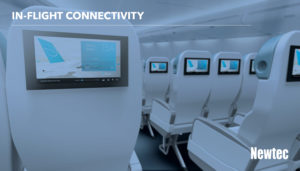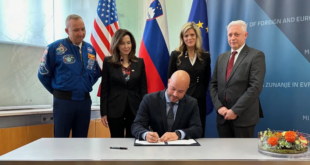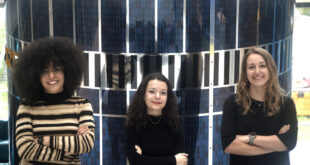
Newtec is at the forefront of innovation in the rapidly growing satellite mobility revolution that provides communications on the move on land, at sea, and in the air. SpaceWatch.Global’s Editor-in-Chief Helen Jameson sat down with Newtec’s Head of Mobility, Andrew Faiola, to discuss Newtec’s role and future in satellite mobility.
Can you tell us about your background in the industry and your new job role at Newtec?
I’ve been in the industry a little over 20 years, most of that with satellite operators, but I got the space bug during an internship at NASA, and also started out working for a teleport operator. I’ve only recently joined Newtec as Head of Mobility, and becoming part of such an innovative company that focuses on ground segment technology has presented a steep, but enjoyable, learning curve. It has really rounded out my exposure to the ecosystem. I’m now bringing my previous experience and combining it with Newtec’s technology and ambitions to define our strategy in Mobility (on land, sea, and air), growing the business by working with the strongest partners in the different segments, and establishing our leadership in this space.
Where is demand for mobility coming from?
The way in which we communicate and what we expect in terms of connectivity is reaching a tipping point that represents a complete transition from what we’ve known as the norm to a new reality, where anything and everything will eventually be connected seamlessly. I’m dating myself, but I was at a conference recently where one of the partipants recounted the sweet succor of hearing his dial-up make that tangible, audible handshake. My kids would have no idea what I am talking about!
When it comes to the ways in which consumers demand data, their usage is now not confined to a physical location. The adoption of Over-the-Top (OTT) services has led to people demanding data for streaming, wherever they are. This is just one example of how expectations for ‘always on’ connectivity have increased in recent years. This shift in expectations has also taken the hunger for services to new realms in the form of the rise in demand for Communications on the Move (COTM) services. For these applications to be possible, a strategic infrastructure of the right kind of connection and the most suitable equipment to carry the service is now required.

Demand is coming from users everywhere – on land, at sea and in the air. Demand for data is everywhere we go and is used for a plethora of different reasons. It might be for passengers to stay in touch with family and friends, to access social media during a long flight or on a cruise, or for a businessperson who needs to conduct a videoconference call whilst on a train, all the way to facilitating important, mission critical situational awareness for on-the-move- government and defence personnel. The rise of broadband connectivity has had a massive effect on individuals, businesses, organisations and governments and making that available on a ubiquitous level is what is required. Terrestrial connectivity cannot reach the middle of an ocean or an aircraft crossing the Atlantic, so this is where satellite technology comes into its own. Meeting this massive demand is what we at Newtec are committed to doing, in an affordable and highly scalable way.
What are the main challenges in terms of making mobile broadband connectivity a reality everywhere?
Our expectations are changing to the point where coverage needs to extend everywhere, no matter how remote. This is not an easy thing for established, terrestrial networks to achieve, yet working with satellite, it can be made possible. This is why, at Newtec, we are focused on what we see as the connectivity mix of the future. There is no one-size-fits-all method of connectivity that will suit every application. It’s going to be a hybrid of different connectivity from terrestrial cellular to copper and fibre, Wi-Fi, microwave and more. It’s going to take more than one to meet the challenge. As new applications such as the Internet of Things (IoT) continue to advance and connected objects become more commonplace, universal high-capacity, high-speed connectivity will become a necessity, anywhere and everywhere. Consequently, the role of satellite will increase, delivering seamless, high-bandwidth broadband services to once unimaginable locations, including out at sea and in the sky.
What changes in the satellite industry itself are happening to enable this new, ubiquitously connected world?
As an industry, we are undergoing profound change towards a new era and a change in satellite capabilities. This will fundamentally affect us as we move forward into the future. The satellite industry is moving towards a more data-centric reality. As we have said, we know that users want access to more data than ever before, and they want this everywhere and it is this demand for data that has been the driving force for the development of new, small satellite ‘mega’ constellations. These will see a move away from the ‘traditional’ geosynchronous orbit into low and medium earth orbits, allowing low latency connectivity due to their much closer proximity to the Earth. This new breed of small satellites carry a variety of different payloads and feature on-board processing. They will demand make-before-break beam handover technology to operate, using newly-developed flat panel antennas that will allow for greater mobility. It’s all change in GEO as well, where not only will highly efficient beam switching on High Throughput Satellite (HTS) systems be required, but entirely new business models and concepts of operations will rise from mission extension vehicles, software-defined payloads, and “small GEOs”.. This demand for high data rates for mobile applications requires a platform that can deal with the industry changes and future connectivity.
The reality of new small satellite constellations has been a priority for Newtec for some time now. Satellites in LEO, MEO and GEO orbits, with varying payloads have different demands so flexibility, agility, and dynamism are essential in order to meet these different requirements. Our technology has to adapt and be flexible enough to accommodate satellites in all orbits and with different capabilities for different applications.
How is Newtec preparing for these new satellites?
Newtec’s technology has already been put to the test in terms of LEO connectivity. We recently performed successful over-the-air tests on Telesat’s inaugural LEO satellite which was launched in January 2018 and Newtec’s technology is being used to demonstrate different service scenarios over the Ka-band satellite. The latest trials, which we announced late last year, saw test user traffic successfully passed over the satellite via Newtec modems, showing that flawless operation of very high-throughput services without packet loss can be achieved on LEO constellations.
The constellation is designed to deliver an unsurpassed combination of capacity, speed, security, resiliency, latency and low cost, delivering affordable fibre-quality connectivity everywhere. Once fully deployed, Telesat LEO will accelerate 4G/5G expansion, delivering fibre-like high-speed services into rural and remote communities, and set new levels of performance for commercial and government broadband on land, sea and in the air. The tests have demonstrated that Newtec’s equipment works seamlessly with LEO satellites and that Newtec’s technology is already able to deliver next-generation connectivity today.
What is Newtec doing in the air to accommodate the demand for In-Flight Connectivity (IFC)?
Newtec’s work within the commercial aviation industry has seen rapid expansion over the last year. Our partnership with Panasonic Avionics, established in 2016, has resulted in the development of a new, high-bandwidth satellite modem which operates over high-capacity satellites such as Intelsat EpicNG, SES-15, Telesat Vantage and Eutelsat 172B. These have been designed to accommodate applications such as in-flight connectivity. We currently are on board over 800 aircraft, over 100 beams and over 25 gateways. It is a large, mature, scaling network that is still in the process of expansion.
The Newtec modem offers Panasonic Avionics’ aero customers up to 20 times the bandwidth of its original solution and can facilitate the increasing bandwidth coming on stream as HTS and Extreme-Throughput Satellite (XTS) services continue to be layered over the its existing global network.

With Panasonic Avionics, Newtec has developed the capability to simultaneously receive live TV and IP data on commercial planes from different beams on the same satellite – a wide beam for TV and a spot beam for data. Panasonic Avionics designed its next-generation HTS network with powerful spot beams for data, overlaid with wide beams for TV. In this scenario, all three receivers on the Newtec aero modem can be leveraged with one receiver for TV and two to handle the switchover between spot beams. This same multiple receiver hardware architecture is also appropriate for handling LEOs when they become available, and Newtec is also working with LEO providers to develop the software required for their satellites. Newtec modems are completely software defined, so upgrades can be delivered remotely via a simple upgrade, eliminating the need to swap out hardware.
How will Newtec’s technology enable the new breed of Flat Panel Antennas (FPAs) that are coming to market?
The new generation of FPAs have enormous potential and are widely considered to be a key factor in enabling mobility. Whilst LEO satellites have the power to allow broadband connectivity everywhere, it is also important that satellite terminals are designed to transmit and receive signals with satellites that are moving quickly in orbit around the Earth. Traditional parabolic antennas can be used for on-the-move communications, but they tend to be heavy and bulky and contain lots of moving parts that can fail. FPAs will enable the expansion into existing and emerging mobility markets such as land transportation and the provision of connectivity to smaller vessels and aircraft. Our aim at Newtec is to enable our customers to expand into these markets using FPAs at the lowest possible OpEx.
We have been working with FPA manufacturer Kymeta, and Newtec partners Liquid Telecom, StratoSat and Intelsat, to demonstrate impressive performance over our Newtec Dialog® platform at the end of last year, on a long road trip across South Africa.
The network tests were run using Newtec’s MDM3310 modem on Liquid Telecom’s Newtec Dialog platform over the Intelsat EpicNGIS-33e Ku-band satellite and achieved the highest available throughput over an Intelsat EpicNGsatellite, even for a contended network service. The system, mounted on top of an SUV, made the journey all the way from Johannesburg to Cape Town, operating continuously during the 1,400km trip, when testing continued. The system performed exceptionally.
How do you see the future of mobility and Newtec’s role in it?
Mobility is set to play a critical part in the future of satellite communications because our dependence upon data means that we need it wherever we go, for a multitude of different reasons. Combine this with the emergence of mega constellations in LEO, that will deliver unrivalled access to high-speed connectivity on land, sea and in the air, and the need to complement terrestrial networks, and we have a very exciting prospect before us.
Newtec is prepared to meet the challenges that this new satellite world places before the industry. It is important now that we unite and embrace the changes that are happening and think about how different types of connectivity must be used in a complementary way to achieve the end goal of ubiquity. Things will soon accelerate. The deployment of the OneWeb constellation has already begun and others will not be too far behind. Our priority is to demonstrate to our customers that they can be safe in the knowledge that our platforms will be able to take them where they want to go – both physically and technologically – way into the future.

Andrew Faiola is currently Head of Mobility at Newtec, where he is responsible for the company’s strategy for aviation, maritime, and land mobile. Previously, Andrew spent 15 years at Intelsat, the world’s leading satellite company, in a number of different direct account management and leadership positions, most recently leading the Mobility Solutions sales team for Europe, Middle East, and Asia. He also held various sales and marketing roles at NewSkies Satellites, and at an independent teleport in the USA called ESATEL Communications. Earlier in his career he performed research and project development work at the Center for Strategic & International Studies (CSIS), the Embassy of Mexico in Washington, DC, and at NASA, which involved the provision of Internet service and remote sensing for environmental purposes.
Andrew holds a BA in Economics from Washington University in St. Louis, and an MA in International Affairs from The George Washington University in Washington, DC.
SpaceWatch.Global thanks Andrew Faiola of Newtec for the interview.





